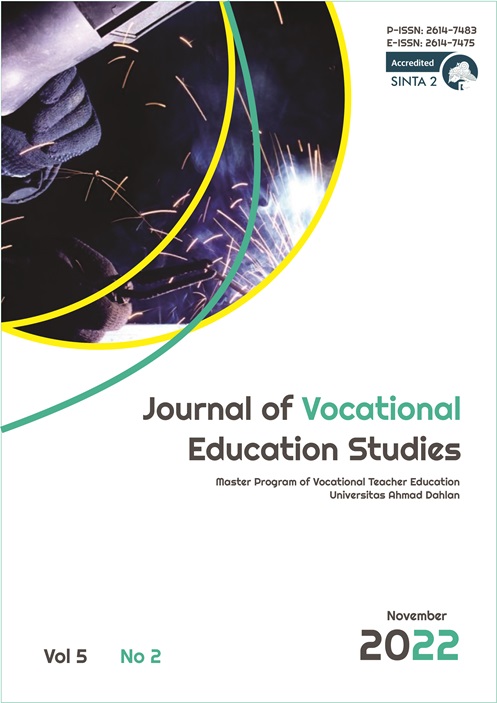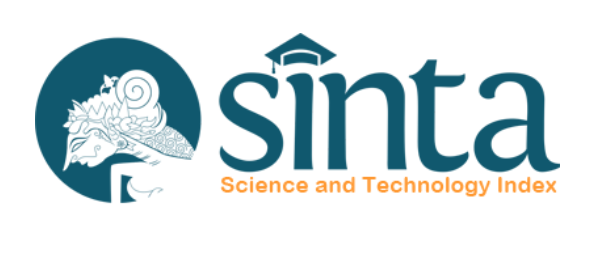Usability of Augmented Reality (AR) Application in ‘Fertigation System’ among Form 1 Students at Sekolah Menengah Kebangsaan Behrang 2020, Perak, Malaysia
DOI:
https://doi.org/10.12928/joves.v5i2.6472Keywords:
Augmented Reality (AR), Fertigation, ADDIE Model, Teaching AidAbstract
The purpose of teaching aid is important to attract students to always be active in the classroom. It is important to focus on educational activities among students such as the usage of teaching aid during the teaching and learning process. Therefore, the objective of this study is to identify the usability of augmented reality (AR) application 'Fertigation System' among form 1 students of SMK Behrang 2020 who took Design and Technology subject. The application was developed using the ADDIE model which has five phases including analysis, design, development, implementation, and evaluation. The design of the studies used was quantitative method (survey method). The instrument of study used was a questionnaire. In the first phase (Analysis), a questionnaire that was endorsed by experts was distributed to 35 respondents to identify the needs of the AR application development. In this phase, there were 72% of respondents agreed the needs of the AR application development. For the next phases, an AR 'Fertigation System' has been designed and developed. A questionnaire was distributed together with the AR application that has been developed and verified by three experts from different fields (language, education, content). After that, a pilot study was conducted among 50 students of form 1 who took Design and Technology subject at SMK Behrang 2020 as respondents for improvement purposes (Implementation phase). For the final phase (Evaluation), a questionnaire and application of AR 'Fertigation System' which has been verified and improved was distributed to 76 respondents comprising form 1 students who took Design and Technology subject at SMK Behrang 2020. The results of this study showed that 62.72% of the respondents strongly agreed with the usability of the AR application 'Fertigation System'. All data obtained was analyzed using the Statistical Package for Social Science (SPSS) to obtain the average value, percentage, frequency and standard deviation. In conclusion, the results of this study show that the AR application of the 'Fertigation System' that has been developed can be used among form 1 students who took Design and Technology subject at SMK Behrang 2020, Perak.
References
AlNajdi, S. M. (2022). The effectiveness of using augmented reality (AR) to enhance student performance: using quick response (QR) codes in student textbooks in the Saudi education system. Educational technology research and development, 1-20.
Aldalalah, O., Ababneh, Z., Bawaneh, A., & Alzubi, W. (2019). Effect of augmented reality and simulation on the achievement of mathematics and visual thinking among students. International Journal of Emerging Technologies in Learning (iJET), 14(18), 164-185.
Altinpulluk, H. (2019). Determining the trends of using augmented reality in education between 2006-2016. Education and Information Technologies, 24(2), 1089-1114.
Bullock, M. (2015). What Makes a Good Teacher? Exploring student and teacher beliefs on good teaching. Rising Tide, 7(1), 1-30.
Faridi, H., Tuli, N., Mantri, A., Singh, G., & Gargrish, S. (2021). A framework utilizing augmented reality to improve critical thinking ability and learning gain of the students in Physics. Computer Applications in Engineering Education, 29(1), 258-273.
Gurevych, R., Silveistr, A., Мokliuk, M., Shaposhnikova, I., Gordiichuk, G., & Saiapina, S. (2021). Using augmented reality technology in higher education institutions. Postmodern Openings, 12(2), 109-132.
Harun, Z. N. (2014). Kompetensi Guru dalam Pengajaran Amali Reka Bentuk dan Teknologi di Sekolah Rendah Daerah Batu Pahat. https://www.semanticscholar.org/paper/Kompetensi-guru-dalam-pengajaran-amali-reka-bentuk-Harun-Nabila/71e364f0412cc8d1d512dae8b2c685a063a319b1/[1 July 2022].
Huuskonen, J. and Oksanen, T. (2018). Soil sampling with drones and augmented reality in precision agriculture. Computers and electronics in agriculture, 154, 25-35.
Ke, F. and Hsu, Y. C. (2015). Mobile augmented-reality artifact creation as a component of mobile computer-supported collaborative learning. The Internet and Higher Education, 26, 33-41.
Masingan, C. B. and Sharif, S. (2019). Pengetahuan Pedagogi Kandungan (PPK) Guru Bukan Pengkhususan Reka Bentuk dan Teknologi (RBT) di Sekolah Menengah. Malaysian Journal of Social Sciences and Humanities (MJSSH), 4(6), 64-71.
Pandey, H., Maurya, A., Prajapati, R., Pandey, A., & Nagve, V. (2020). Augmented Reality in Agriculture (No. 2752). EasyChair.
Saidin, N. F., Halim, N. D. A., & Yahaya, N. (2015). A review of research on augmented reality in education: Advantages and applications. International education studies, 8(13), 1-8.
Zayyadi, M., Supardi, L., & Misriyana, S. (2017). Pemanfaatan Teknologi Komputer Sebagai Media Pembelajaran Pada Guru Matematika. Jurnal Pengabdian Masyarakat Borneo, 1(2),25.https://doi.org/10.35334/jpmb.v1i2.298.
Downloads
Published
Issue
Section
License
Copyright (c) 2022 Universitas Ahmad Dahlan

This work is licensed under a Creative Commons Attribution-ShareAlike 4.0 International License.
Authors who publish with Journal of Vocational Education Studies (JOVES) agree to the following terms: Authors retain the copyright and grant the Universitas Ahmad Dahlan right of first publication with the work simultaneously licensed under a Creative Commons Attribution License (CC BY-SA 4.0) that allows others to share (copy and redistribute the material in any medium or format) and adapt (remix, transform, and build upon the material) the work for any purpose, even commercially with an acknowledgement of the work's authorship and initial publication in Universitas Ahmad Dahlan. Authors are able to enter into separate, additional contractual arrangements for the non-exclusive distribution of the journal's published version of the work (e.g., post it to an institutional repository or publish it in a book), with an acknowledgement of its initial publication in Universitas Ahmad Dahlan. Authors are permitted and encouraged to post their work online (e.g., in institutional repositories or on their website) prior to and during the submission process, as it can lead to productive exchanges, as well as earlier and greater citation of published work (See The Effect of Open Access).










.png)



